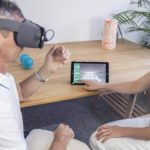 A couple of years ago I wrote about a startup, called Immersive Rehab, which used virtual reality (VR) to help people recover after a stroke. They were part of a number of startups operating in this field. The promise of the technology was underlined by a recent study from North Carolina State University, which highlighted how VR can prove effective at encouraging physiotherapy participation.
A couple of years ago I wrote about a startup, called Immersive Rehab, which used virtual reality (VR) to help people recover after a stroke. They were part of a number of startups operating in this field. The promise of the technology was underlined by a recent study from North Carolina State University, which highlighted how VR can prove effective at encouraging physiotherapy participation.
“Physical and occupational therapy are important parts of stroke recovery, in terms of helping survivors regain dexterity and functional motor ability,” the researchers say. “However, stroke survivors often face significant challenges in attending their therapy sessions. For example, many survivors don’t live near facilities that offer relevant therapy services.”
The researchers set out to create a virtual reality platform that allowed patients to interact with their therapists in real-time. The system, which was called Virtual Environment for Rehabilitative Gaming Exercises (VERGE), uses Kinect motion-sensor hardware to track the movement of both the patient and the therapist. At the time of writing, the platform supports three different exercises to aid in the rehabilitation of the patient.
Put to the test
The system was tested on 20 stroke survivors, all of which had chronic impairments. Half of the volunteers used VERGE for a fortnight in single-user mode, with the remaining half using it in multi-user mode. They then switched for another two weeks.
The results revealed that the volunteers attended 99% of their therapy sessions in multi-user mode, with 89% attendance in single-user mode. What’s more, they also spent on average 22% more time in the sessions when using the multi-user mode, with more exercises completed during that time.
“This suggests that the social aspect of VERGE has real benefits for stroke survivors in the context of getting them engaged in therapy,” the researchers say.
The tests were conducted using the upper extremity portion of the Fugl-Meyer Assessment of Recovery after Stroke to measure the effectiveness of the sessions, with each user reporting an average change of 3.2. This is the kind of score that would typically be seen after four weeks of therapy in a more conventional setting.
“The fundamental takeaway here is that VERGE has the potential to be a means of bringing clinical therapy to stroke survivors in their homes,” the researchers say.
The next step is to test it in a much larger setting, with a multi-site study being conducted to ensure the findings are robust enough to warrant scaling up into a more typical clinical setting. They also want to test whether involving loved ones in the therapy could further improve engagement with the exercises.
“In the longer term, we’d like to see if this could be a means of engaging in therapy remotely with burn survivors, or even as a means of encouraging older adults to engage in exercise and make social connections,” they explain. “In terms of potential harms, there are very few. It’s possible that some people may experience motion sickness if they use virtual reality goggles rather than using a large screen or monitor. Otherwise, the only risk we can think of is soreness from unaccustomed activity.”